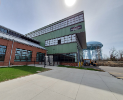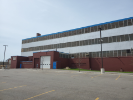Near-Term Strategies for the Northland Campus

Buffalo Manufacturing Works, Northland. Photo: Charles Wingfelder
For decades, the area around Northland Avenue suffered from divestment and abandonment, especially as many of its former manufacturing anchors succumbed to outside economic forces. Due to the adjacent Belt Line railroad, the corridor had become a strategic industrial hub able to move both people and products en masse. Once home to manufacturers such as Houdaille Industries, Otis Elevator Company, Curtiss-Wright Corporation, Northland Rubber Company, and Niagara Machine & Tool Works (later Clearing Niagara), the products that left the loading docks went on to forge modern America. A blue-collar workforce, building aircraft engines, plunger elevators, and automobile parts, established residency near their employers starting around the turn of the 20th Century. Over time, this pattern of settlement formed the Delavan Grider neighborhood we know today.
Gallery
Students
Kennedy Alexis, Sydney Alford, Qais Alqaddah, Justyn Bellitto, Eric Benz, Camile Brown, Michael Burton, Elise Cloutier, Joseph Crispus Karanja, David Kelly, Daniela Leon, Alison Liang, Sean McGranaghan, Melanie Monroy, Angelo Rhodes, Jasraj Sandhu, Tanner Schmit
Faculty
Term
END593/URP581/URP582
Fall 2020
Program
MUP, MSRED
Northland In Its Community
As Buffalo entered into its PostIndustrial epoch, the once dynamic cluster of manufacturers slowly faded into history. This narrative of decline has manifested itself in both spatial and demographic changes within the surrounding neighborhood. Once a dense and walkable community, it is now less-conducive to pedestrian interaction and high in housing vacancy rates. Changes in the fortunes of Northland over the years have been borne by nearby residents, with 35.6% of the surrounding Masten District community living below the poverty line. As of August 2020, this same area had the highest unemployment rate in the city at 11.3%. Overall, the housing profile indicates only 24.6% of homes are owner-occupied while 60.3% are rented. The demographics of the neighborhood also have changed over the years, from a predominantly German and Eastern European population, to today’s 82% Black/African American makeup. Despite a popular perception of decay, the areas surrounding the Northland core (the Masten District) are still home to an aggregate of 27,671 people and an already existing vibrancy that cannot be ignored.
The surrounding neighborhood has assets and stakeholders already active in shaping the future of the Northland Campus. Well-established community organizations, institutions, and places of worship serve as a network for opportunities to support social livelihood and economic sustainability. Examples of actors providing capacity-building and direct service include: Delavan Grider Community Center (Metro CDC), Mt. Olive Church/Mt. Olive Development Corporation (MODC), True Bethel Church/True Community Development Corp (TCDC), Northland Beltline Taxpayers Association, and Erie County Medical Center (ECMC).
The Role of the Buffalo Urban Development Corporation
In 2014, bolstered by Governor Cuomo’s Buffalo Billion and Empire State Development funding, the Buffalo Urban Development Corporation (BUDC) acquired more than 35 acres of vacant land and roughly 700,000 square feet of under-utilized industrial space on Buffalo’s East Side. This Brownfield redevelopment project came with a vision to not only reactivate employment within the campus, but to also revitalize a neighborhood long suffering from neglect. As the City of Buffalo’s not-for-profit development agency, the Buffalo Urban Development Corporation’s (BUDC) role at Northland represents a case study on the positive impact of public benefit corporations in developing urban areas ignored by private investors.
Since the inception of the Northland Campus, BUDC has spearheaded its economic development efforts, overcoming many obstacles during that time. Their primary roles include land acquisition, creation of shovel-ready sites, rehabilitation of formerly distressed properties, and attracting new business to the campus. The aim of BUDC is to create an urban industry cluster focused on advanced manufacturing and innovation, with an integrated workforce training component. With investment by New York State through Empire State Development, the agency has transformed the appearance and spirit of the Northland Campus.
In the Summer of 2018, the Northland Workforce Training Center opened its doors after a $44 million investment, transforming the long dormant Northland Central Building. The successes continued in 2019 after the Albright-Knox Art Gallery announced the opening of an exhibition space on Northland Avenue. Open since January 2020, it marks a new chapter in cultivating a cultural identity for Northland beyond solely manufacturing. The year 2019 also saw the completion of the first phase of streetscape and green infrastructure improvements, a step contributing to a larger strategy of placemaking within and around the campus.
Fast forward to the present day and 2020 has marked the start of a new juncture for the campus. Northland Central was leased nearly to full capacity in just a few short years, bringing in outside companies to call the area their new home. These businesses represent a cluster of firms focused on advanced manufacturing, engineering, and life sciences. Finally, recently completed BUDC land swaps and the Buffalo Planning Board’s approval for the Houdaille property division equate to new, high-level hovel-ready sites to expand upon the investment opportunities within the campus. The BUDC leadership team requested this joint studios’ involvement in creating visions for the campus that complement the successes already achieved.
Moving Forward
While the report seeks to capitalize on the successes and strengths of the Northland Campus, it is prudent to advance a proposal forward with a recognition of historic troubles and future challenges. Due to current economic uncertainty, funding flexibility and creativity will be required to advance future phases of development. Likewise, the campus faces competition; this comes from not only cities of similar market size, but also from other industrial reactivation corridors in the region. While this report presents proposals intended to foster wider neighborhood stability and vitality, systemic issues still persist such as: food inaccessibility, crime, limited educational attainment, an aging housing stock, and lack of environmental sustainability. This report and the recommended actions therein seek to further anchor the Northland Campus as a community institution with a greater stake in the holistic social revitalization of the community.
Recommendations
Following a comprehensive investigation into the Northland Campus, and the confluence of the sociology, geography, history, economics, and precedent surrounding it, this report outlines the framework for the following recommendations:
• A Tech Incubator and/or a Life Science building, with two site options presented.
• A Flex Industrial building and/or Warehousing, with two possible phases described.
• Three special initiatives, including a commercial condominium with four site options presented, a renewable energy initiative, and a manufactured housing research facility.
• Improved community connections leading to the proposal of a new Houdaille Place Event Space and significant investment in greenways and bikeways


